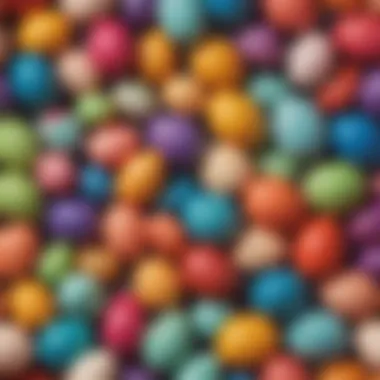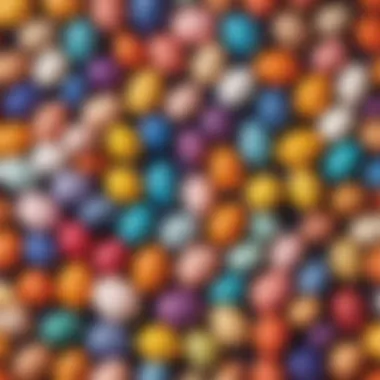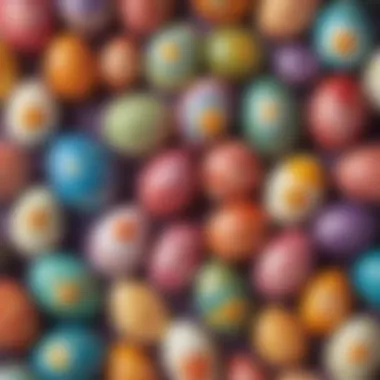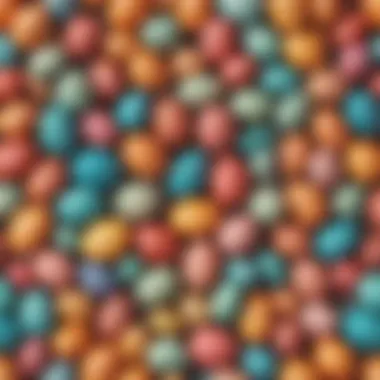Step-by-Step Guide for Dyeing Eggs with Food Coloring at Home


Science Fun Facts
If you've ever wondered about the fascinating world of color, then creating vibrant egg dyes using food coloring will surely amaze you! Color is just light waves making your world bright and beautiful. Do you know that the food coloring mixes with the eggshell, creating colorful swirls that tell a story of diffusion and absorption? It's like magic happening right before your eyes!
Discover the Wonders of Science
Exploring the science behind how colors blend and change can be an exciting journey. Imagine water and vinegar acting as solvents, breaking down the dye's molecules, allowing the color to seep into the porous eggshells. These concoctions create a kaleidoscope of hues, showcasing the enchanting art of color mixing at its best.
Science Experiment Showcase
Embark on a colorful adventure by trying out this simple yet captivating experiment with food coloring and eggs. Gather your materials - cups, spoons, food coloring, water, and vinegar. Safety first, so remember to work in a well-ventilated area and have an adult to assist with the boiling water. Follow the step-by-step instructions carefully, ensuring a successful outcome and colorful creations that will brighten up your Easter festivities!
Recipe for Dyeing Eggs with Food Coloring: A Fun and Creative Activity for Children
Introduction
Dyeing eggs with food coloring is a delightful and engaging activity that brings a pop of color to the festive season. It's not just about coloring eggs; it's a process that involves creativity, precision, and a dash of patience. By following this recipe, you are embarking on a journey to transform simple eggs into vibrant works of art.


Understanding the Process
To understand the process of dyeing eggs with food coloring, it is essential to grasp the science behind how colors can seep into the porous eggshells. When eggs are boiled, tiny cracks form on the shell's surface, allowing the dye to penetrate and create beautiful hues. This method is not only visually appealing but also educational, offering insights into absorption and color mixing.
Importance of Using Food Coloring
The choice of food coloring plays a crucial role in producing vividly colored eggs. Food coloring is specially formulated to be safe for consumption, making it an ideal option for dyeing eggs. Additionally, food coloring offers a wide range of colors, giving you the freedom to experiment and create custom hues. Ensuring the quality of food coloring used results in vibrant and long-lasting coloration, making the eggs stand out as delightful decorative pieces.
Materials Needed
When embarking on the colorful journey of dyeing eggs using food coloring, it is imperative to gather all the essential materials beforehand. The success of this creative activity hinges on the quality and adequacy of the items utilized. By ensuring you have everything at your disposal, you can dive into the process seamlessly, fostering a smooth and enjoyable experience for both you and your little ones.
List of Required Items
To begin with, you will need a carton of fresh eggs. Opt for white eggs to achieve the most vibrant and striking colors once they are dyed. Make sure the eggs are at room temperature before you commence the dyeing process.
Next, acquire food coloring in an array of hues. You can either use liquid food coloring or opt for gel-based coloring, depending on your preference and availability. Choose colors that are bold and vivid to produce eye-catching results. Have a variety of colors on hand to create a diverse selection of dyed eggs.
Prepare white vinegar for setting the dye on the eggs. Vinegar plays a crucial role in the dyeing process, as it helps the color adhere to the eggshells more effectively. Additionally, you will need boiling water to create the dye solution. Ensure the water is hot enough to dissolve the food coloring thoroughly and create a uniform color for dyeing the eggs.


Lastly, gather several small bowls or cups to mix and hold the dye solutions. These containers should be deep enough to submerge the eggs fully for an even coating of color. Having separate containers for each color allows you to mix and customize the hues according to your preferences. Have some paper towels or a drying rack ready to place the dyed eggs to dry once the coloring process is complete.
Step-by-Step Guide
To create beautifully colored eggs using food coloring, you need to follow a precise step-by-step process. This ensures that the dye adheres well to the eggs, resulting in vibrant and aesthetically pleasing final products. The Step-by-Step Guide plays a crucial role in this article as it outlines the entire procedure from start to finish, making it easy for both children and adults to follow along and engage in this creative activity. By breaking down each task into manageable steps, the guide eliminates confusion and empowers individuals to produce stunning dyed eggs with food coloring.
Preparing the Eggs
Before diving into the dyeing process, it's essential to prepare the eggs properly to achieve optimal results. This involves two main steps: Boiling the Eggs and Cooling the Eggs.
Boiling the Eggs
Boiling the eggs ensures that they are thoroughly cooked, making them safe to consume once they are dyed. It also helps in creating a solid base for the dye to adhere to, enhancing the overall color vibrancy of the eggs. The boiling process involves simmering the eggs in hot water until they reach the desired level of doneness. This is a popular method due to its simplicity and effectiveness in preparing eggs for dyeing purposes. While boiling the eggs, it is crucial to monitor the cooking time to prevent overcooking, which can result in rubbery textures.
Cooling the Eggs
Once the eggs are boiled, they must be promptly cooled to room temperature before proceeding with the dyeing process. Cooling the eggs halts the cooking process and prevents them from becoming overcooked. This step is pivotal as it ensures that the eggs are ready to absorb the dye evenly, creating consistent and vibrant colors. Allowing the eggs to cool also makes handling them easier, minimizing the risk of accidental cracks or damage during the dyeing phase.
Creating the Dye Solution


The next step in the process is to prepare the dye solution, which consists of Mixing Water and Vinegar and Adding Food Coloring.
Mixing Water and Vinegar
The combination of water and vinegar serves as the base for the dye solution, providing the necessary acidity to help the coloring adhere to the eggs effectively. The water dilutes the dye, ensuring that the colors are not too intense or concentrated, while the vinegar aids in setting the color and producing vibrant hues. This step is crucial in achieving bright and long-lasting coloration on the eggs, making them visually appealing and engaging for both children and adults.
Adding Food Coloring
Tips for Best Results
When it comes to achieving the best results in dyeing eggs with food coloring, following some key tips can make a significant difference in the outcome. One essential factor to consider is the timing and patience required throughout the egg-dyeing process. As the eggs undergo the dyeing method, it is crucial to exercise patience and allow sufficient time for the colors to develop fully. Rushing through the steps can result in uneven or pale coloring, detracting from the overall aesthetic of the eggs. Emphasizing the importance of timing and patience to children participating in this creative activity not only instills a sense of precision but also teaches the value of diligence and attention to detail.
Beyond the aspect of timing and patience, enhancing color vibrancy is another crucial element in achieving visually appealing results from dyeing eggs with food coloring. To enhance the vibrancy of the colors, consider adjusting the concentration of dye in the solution. Experimenting with different ratios of food coloring to water can lead to richer and more intense hues on the eggs. Additionally, the duration of time the eggs spend in the dye solution can impact the final color outcome. Allowing the eggs to soak for an adequate period ensures that the pigments adhere evenly, resulting in vibrant and eye-catching eggs that are sure to impress. By focusing on enhancing color vibrancy, children engage in a creative process that encourages experimentation and observation of color transformations, fostering an appreciation for the art of dyeing eggs with food coloring.
Conclusion
Dyeing eggs with food coloring is not just a creative activity but also a fantastic way to engage children in a fun and educational experience. In this article, we have explored the step-by-step process of dyeing eggs using food coloring, from preparing the dye solution to showcasing the vibrant results. This hands-on activity allows children to understand the science behind color absorption while fostering their creativity and patience. By following this guide, children can develop their fine motor skills through delicate egg handling and enhance their sensory experience by observing the transformation of plain eggs into colorful creations. Moreover, this activity promotes bonding between parents and children, creating lasting memories through shared moments of joy and learning.
Enjoying the Process
Engaging in the process of dyeing eggs with food coloring can be a delightful and enriching experience for children. From carefully selecting the colors to watching the eggs absorb the vibrant shades, every step offers a sense of anticipation and wonder. Children can take pride in their creations, fostering a sense of accomplishment and boosting their self-esteem. Furthermore, this hands-on activity encourages children to explore their creativity, experiment with different color combinations, and express themselves artistically. By providing a sensory-rich experience, dyeing eggs with food coloring stimulates children's curiosity and imagination, making learning a fun and engaging journey.
Showcasing the Results
Once the eggs are dyed and dried, showcasing the results becomes a gratifying moment for children. Displaying the colorful eggs in a decorative manner allows children to appreciate their work and share their creations with family and friends. This process not only celebrates the achievements of the young artists but also encourages them to take pride in their creativity and attention to detail. Showcasing the dyed eggs can serve as a visual representation of the effort and creativity invested, sparking conversations and creating a sense of pride in one's work. Through this display, children can bask in the admiration of their peers and loved ones, further fuelling their passion for artistic expression and experimentation.







